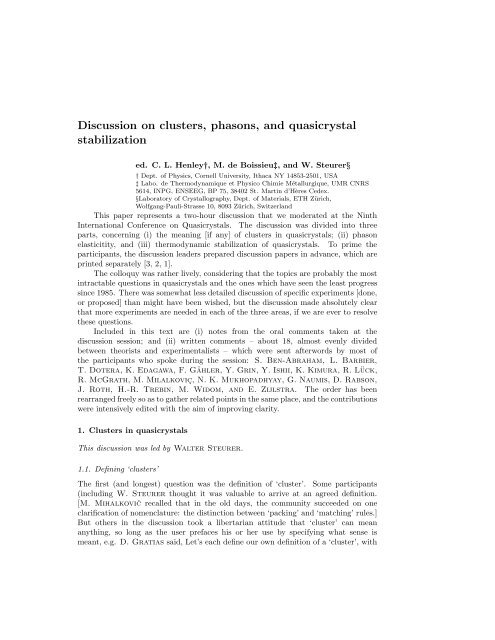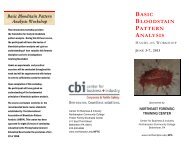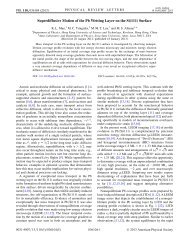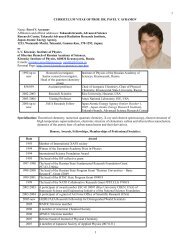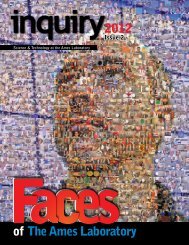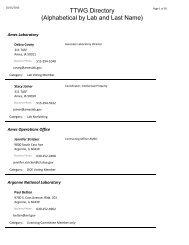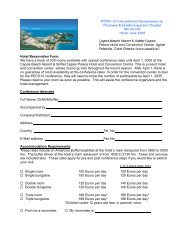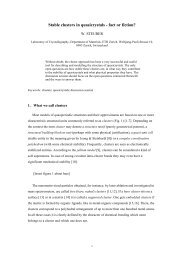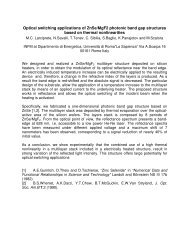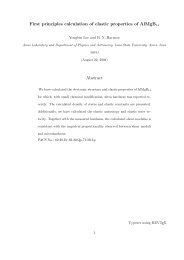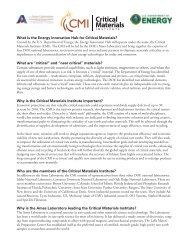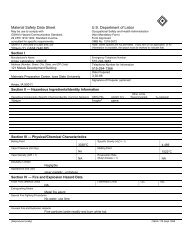Discussion on clusters, phasons, and quasicrystal stabilization
Discussion on clusters, phasons, and quasicrystal stabilization
Discussion on clusters, phasons, and quasicrystal stabilization
Create successful ePaper yourself
Turn your PDF publications into a flip-book with our unique Google optimized e-Paper software.
<str<strong>on</strong>g>Discussi<strong>on</strong></str<strong>on</strong>g> <strong>on</strong> <strong>clusters</strong>, phas<strong>on</strong>s, <strong>and</strong> <strong>quasicrystal</strong>stabilizati<strong>on</strong>ed. C. L. Henley†, M. de Boissieu‡, <strong>and</strong> W. Steurer§† Dept. of Physics, Cornell University, Ithaca NY 14853-2501, USA‡ Labo. de Thermodynamique et Physico Chimie Métallurgique, UMR CNRS5614, INPG, ENSEEG, BP 75, 38402 St. Martin d’Hères Cedex.§Laboratory of Crystallography, Dept. of Materials, ETH Zürich,Wolfgang-Pauli-Strasse 10, 8093 Zürich, Switzerl<strong>and</strong>This paper represents a two-hour discussi<strong>on</strong> that we moderated at the NinthInternati<strong>on</strong>al C<strong>on</strong>ference <strong>on</strong> Quasicrystals. The discussi<strong>on</strong> was divided into threeparts, c<strong>on</strong>cerning (i) the meaning [if any] of <strong>clusters</strong> in <strong>quasicrystal</strong>s; (ii) phas<strong>on</strong>elasticitity, <strong>and</strong> (iii) thermodynamic stabilizati<strong>on</strong> of <strong>quasicrystal</strong>s. To prime theparticipants, the discussi<strong>on</strong> leaders prepared discussi<strong>on</strong> papers in advance, which areprinted separately [3, 2, 1].The colloquy was rather lively, c<strong>on</strong>sidering that the topics are probably the mostintractable questi<strong>on</strong>s in <strong>quasicrystal</strong>s <strong>and</strong> the <strong>on</strong>es which have seen the least progresssince 1985. There was somewhat less detailed discussi<strong>on</strong> of specific experiments [d<strong>on</strong>e,or proposed] than might have been wished, but the discussi<strong>on</strong> made absolutely clearthat more experiments are needed in each of the three areas, if we are ever to resolvethese questi<strong>on</strong>s.Included in this text are (i) notes from the oral comments taken at thediscussi<strong>on</strong> sessi<strong>on</strong>; <strong>and</strong> (ii) written comments – about 18, almost evenly dividedbetween theorists <strong>and</strong> experimentalists – which were sent afterwords by most ofthe participants who spoke during the sessi<strong>on</strong>: S. Ben-Abraham, L. Barbier,T. Dotera, K. Edagawa, F. Gähler, Y. Grin, Y. Ishii, K. Kimura, R. Lück,R. McGrath, M. Milalkoviç, N. K. Mukhopadhyay, G. Naumis, D. Rabs<strong>on</strong>,J. Roth, H.-R. Trebin, M. Widom, <strong>and</strong> E. Zijlstra. The order has beenrearranged freely so as to gather related points in the same place, <strong>and</strong> the c<strong>on</strong>tributi<strong>on</strong>swere intensively edited with the aim of improving clarity.1. Clusters in <strong>quasicrystal</strong>sThis discussi<strong>on</strong> was led by Walter Steurer.1.1. Defining ‘<strong>clusters</strong>’The first (<strong>and</strong> l<strong>on</strong>gest) questi<strong>on</strong> was the definiti<strong>on</strong> of ‘cluster’. Some participants(including W. Steurer thought it was valuable to arrive at an agreed definiti<strong>on</strong>.[M. Mihalkovič recalled that in the old days, the community succeeded <strong>on</strong> <strong>on</strong>eclarificati<strong>on</strong> of nomenclature: the distincti<strong>on</strong> between ‘packing’ <strong>and</strong> ‘matching’ rules.]But others in the discussi<strong>on</strong> took a libertarian attitude that ‘cluster’ can meananything, so l<strong>on</strong>g as the user prefaces his or her use by specifying what sense ismeant, e.g. D. Gratias said, Let’s each define our own definiti<strong>on</strong> of a ‘cluster’, with
Clusters, phas<strong>on</strong>s, <strong>and</strong> stabilizati<strong>on</strong> 2a meaning limited to that talk or paper. F. Gähler replied, it’s just importantthat each time we use it, we say what we mean. M. Mihalkovič observed that thequesti<strong>on</strong> of the physical reality of <strong>clusters</strong> is different from questi<strong>on</strong> of synchr<strong>on</strong>izingour dicti<strong>on</strong>aries. We should not focus <strong>on</strong> finding the ‘best’ definiti<strong>on</strong> for ‘cluster’, butmerely <strong>on</strong> eliminating any clearly misleading c<strong>on</strong>cepts or terms.The main tensi<strong>on</strong> was between geometrical definiti<strong>on</strong>s – based <strong>on</strong> purely structuraldata – <strong>and</strong> chemical definiti<strong>on</strong>s including some criteri<strong>on</strong> about b<strong>on</strong>ding. Thepracticality of a b<strong>on</strong>ding criteri<strong>on</strong> tends to hang, of course, <strong>on</strong> the experimentalquesti<strong>on</strong> whether str<strong>on</strong>gly-b<strong>on</strong>ded atom <strong>clusters</strong> actually exist in <strong>quasicrystal</strong>s, whichis discussed later in three micro-reviews (Subsec. 1.4,1.5, <strong>and</strong> 1.6. [In additi<strong>on</strong>,P. A. Thiel w<strong>on</strong>dered if the results presented at this c<strong>on</strong>ference <strong>on</strong> bulk metglassesrelated to <strong>quasicrystal</strong>s were evidence in favor of <strong>clusters</strong>; however W. Steurercauti<strong>on</strong>ed that nanocrystals might be an equally good explanati<strong>on</strong>.]It is amusing that for some participants, n<strong>on</strong>-overlapping is an automatic attributeof a ‘cluster’, yet for others, certain ‘<strong>clusters</strong>’ are of interest precisely because theycompletely – <strong>and</strong> overlappingly – cover the whole <strong>quasicrystal</strong> structure.Michael Widom: ‘a group of atoms that [repeats <strong>and</strong>] fills space’.David Rabs<strong>on</strong>: ‘a geometric assemblage that maximizes coordinati<strong>on</strong> number’.Chris Henley: ‘a group of atoms which always stay together in some ensemble.’Gerardo Pay-Gomez emended this to ‘the largest group of atoms which ...’ [‘Staytogether’ was meant here in a geometrical or statistical sense, not b<strong>on</strong>ding sense.]Henley’s point was, the ensemble is implicit whenever we talk about <strong>clusters</strong>.That is, a ‘cluster’ must appear in more than <strong>on</strong>e envir<strong>on</strong>ment, or in more than <strong>on</strong>estructure. [Pay-Gomez comments: Finding a cluster <strong>on</strong> the basis of just (say) the1/1 approximant of the i-CdTb <strong>quasicrystal</strong> is like estimating the slope of a curvewhen you have just <strong>on</strong>e point!] When we are c<strong>on</strong>cerned with energetics, this ensemblewould be the set of all low-energy structures; when we are c<strong>on</strong>cerned with cleavage, theensemble would be the cleavage surfaces after many trials with equivalent c<strong>on</strong>diti<strong>on</strong>s.Hans-Reiner Trebin: The definiti<strong>on</strong> of ‘cluster’ must incorporate the following(i) these repeating units must cover most of the atoms (ii) The cluster centers providea coarse-grained descripti<strong>on</strong> of the system’s physics. (iii) Often <strong>clusters</strong> are easier toobserve [as e.g. in electr<strong>on</strong> diffracti<strong>on</strong>]. [This is elaborated later in Subsec. 1.2.]Gerardo Naumis did not have a definiti<strong>on</strong> to add, but c<strong>on</strong>curs with theviewpoint of coarse graining [as being important in the cluster idea], since usuallythere is a hierarchy of forces, divided into intra- <strong>and</strong> inter-cluster forces. Theis agreed:the reas<strong>on</strong> we need ‘<strong>clusters</strong>’, is to implement a new ‘coarsened’ picture of the systemthat embodies the physical properties.Yuri Grin: [The term ‘cluster’ ought to have a meaning similar to its chemicaldefiniti<strong>on</strong>.] That is, the interacti<strong>on</strong> within a cluster differs from [is str<strong>on</strong>ger than]that outside the cluster. Any attempt to define structures geometrically has anarbitrariness. [But until the higher relative stability of the <strong>quasicrystal</strong> (QC) <strong>clusters</strong>with respect to their envir<strong>on</strong>ment can be clearly c<strong>on</strong>firmed, it would be reas<strong>on</strong>able tostate that the term ‘QC cluster’ is used in the sense of the system of nested polyhedra.]G. Kreiner: As a chemist working in the field of <strong>quasicrystal</strong>s, I openly d<strong>on</strong>’tuse ‘cluster’ in its original, chemical sense, which would require us to first solve theproblem of b<strong>on</strong>ding [for the material in questi<strong>on</strong>]. A working definiti<strong>on</strong> would be ‘ageometrical entity which can be used for predicti<strong>on</strong>.’Eeuwe Zijlstra expressed support for Yuri Grin’s view: if the st<strong>and</strong>ardmeaning of ‘cluster’ in chemistry is ‘stable structural unit’, he str<strong>on</strong>gly feels that
Clusters, phas<strong>on</strong>s, <strong>and</strong> stabilizati<strong>on</strong> 3we should adhere to this definiti<strong>on</strong>. Too many words are being used differently by<strong>quasicrystal</strong> scientists than by all other physicists. To reduce the risk of c<strong>on</strong>fusi<strong>on</strong>,let us call these objects, for example ‘<strong>quasicrystal</strong> <strong>clusters</strong>’; just as people know‘herbal tea’ is not really tea, we can assume they will infer that ‘<strong>quasicrystal</strong> <strong>clusters</strong>’are not necessarily real <strong>clusters</strong> (in the sense of stable structural units). [Henleyasks: what about the other usages of ‘cluster’ e.g. the ‘Mayer Cluster Expansi<strong>on</strong>’ instatistical mechanics?] It would be great if we distinguished these different meaningsby qualifying them as e.g. ‘covering cluster’, ‘stable cluster’, ‘<strong>quasicrystal</strong> cluster’ (forthe polyhedral shells used in structural models), etc.John Cahn: A definiti<strong>on</strong> must be short <strong>and</strong> it must be easy to test whetherit applies in any case. The sec<strong>on</strong>d criteri<strong>on</strong> leads him to favor a geometrical ratherthan an energetic definiti<strong>on</strong>. A good definiti<strong>on</strong> should be fruitful too: e.g. if we find<strong>clusters</strong> frequently, we can infer or guess them in another material.Clusters are clearly well-defined in a vapor phase. And many of these ideas applyto molecular solids, e.g. benzene in a benzene crystal. But metallic b<strong>on</strong>ding has al<strong>on</strong>ger range than chemical b<strong>on</strong>ding. Furthermore, in a truly quasiperiodic structure[e.g. the Penrose tiling with inflati<strong>on</strong> symmetry], we have <strong>clusters</strong> at all scales. Weneed to a useful definiti<strong>on</strong> of ‘cluster’! Cahn asks, must there be a clean separati<strong>on</strong>of a cluster from the matrix which surrounds it?Shelomo Ben-Abraham: An isolated cluster of atoms, such as produced forinstance by evaporati<strong>on</strong>, is well defined geometrically, chemically <strong>and</strong> physically.What we are dealing with in the c<strong>on</strong>text of <strong>quasicrystal</strong>s, complex (inter)metallicalloys, ‡ <strong>and</strong> more generally aperiodic c<strong>on</strong>densed matter, is quite another thing. Inthis c<strong>on</strong>text, ‘cluster’ is a flexible c<strong>on</strong>ceptual tool, mostly a shorth<strong>and</strong> expressi<strong>on</strong>. Weusually designate as a cluster an arrangement of coordinati<strong>on</strong> polyhedra, perhaps withsome peripheral additi<strong>on</strong>s; for the <strong>on</strong>es with accepted names (‘Bergman’ or ‘Mackay’<strong>clusters</strong>) this suffices to specify what is meant by cluster. Such an ‘cluster’ may , ineach case, be well defined geometrically but has hardly any precise chemical <strong>and</strong>/orphysical meaning, <strong>and</strong> perhaps it is not possible to assign <strong>on</strong>e.Hence, it is impossible <strong>and</strong> unnecessary to try to establish a formal definiti<strong>on</strong> ofa cluster. When dealing with an abstract geometrical structure (a packing, a tiling, acovering, a point set) it is preferable, in Ben-Abraham’s humble opini<strong>on</strong>, to refrainfrom using the term ‘cluster’ <strong>and</strong>, instead, to talk about ‘a patch’.Johannes Roth c<strong>on</strong>sidered it important to menti<strong>on</strong> that the <strong>clusters</strong> highlightedappear nearly always to be spherical or [as in decag<strong>on</strong>als] cylinders of infinite extent in<strong>on</strong>e directi<strong>on</strong>. They are never el<strong>on</strong>gated like an ellipsoid, although that would not beunnatural in certain of the tilings. [That is, perhaps people have an unc<strong>on</strong>sciousa priori bias towards particular kinds of clusers, <strong>and</strong> have not necessarily takenalternatives into c<strong>on</strong>siderti<strong>on</strong>.] Or should the definiti<strong>on</strong> of ‘cluster’ explicitly restrictthe shape? N. Mukhopadhyay w<strong>on</strong>dered, should we impose a lower bound <strong>on</strong>the size of a ‘cluster’; does it need to have multiple shells? C. L. Henley <strong>and</strong>M. Mihalkovič noted that, since the interacti<strong>on</strong>s resp<strong>on</strong>sible for stabilizati<strong>on</strong> arel<strong>on</strong>g-ranged in metals – <strong>and</strong> oscillating, as seen in pair-potential modeling – it mighteven make sense to define a ‘cluster’ in the shape of an annulus or decag<strong>on</strong>al ring,without including the interior atoms [Those could be in varying c<strong>on</strong>figurati<strong>on</strong>s, as in‘pseudo-Mackay’ <strong>clusters</strong>, or the i-CdYb cluster.]‡ Ben-Abraham suggests the abbreviati<strong>on</strong> CIMA (in place of the now accepted CMA) which (a)is more adequate; (b) can be pr<strong>on</strong>ounced as a word; (c) means ‘the top, summit’ in a variety ofRomance languages (!).
Clusters, phas<strong>on</strong>s, <strong>and</strong> stabilizati<strong>on</strong> 4R. Lück agrees that the term ‘cluster’ has been applied with a variety ofmeanings to different properties of matter. For instance, in Kikuchi’s ‘cluster variati<strong>on</strong>method’ [4], ‘cluster’ means a geometrical c<strong>on</strong>struct to compute the c<strong>on</strong>figurati<strong>on</strong>entropy of a given material. Again, the term ‘clustering’ is used to describe theatomic arrangement of an alloy when neighboring atoms are observed to be identicalspecies more frequently than in a r<strong>and</strong>om arrangement; it describes the opposite ofchemical short range order.These two examples show that there is no general, unique underst<strong>and</strong>ing of theterm ‘cluster’; in both cases, nothing is said about binding energies within or out ofthe assumed cluster (as was proposed to be a c<strong>on</strong>diti<strong>on</strong> for ‘cluster’ by Yu. Grin).Lück, in any article menti<strong>on</strong>ing a ‘cluster’, would define or explain this term in theintroducti<strong>on</strong> to avoid c<strong>on</strong>fusi<strong>on</strong>, just as any unfamiliar abbreviati<strong>on</strong> or acr<strong>on</strong>ym shouldbe defined.N. K. Mukhopadhyay believes we all underst<strong>and</strong> ‘cluster’ to mean somegrouping of atoms possessing short- or medium- range order, <strong>and</strong> having someproperties different from rest of the atoms. This can also be c<strong>on</strong>sidered as a motif orbuilding block in the solid structures. For example, in the T -Mg 32 (Al,Zn) 49 <strong>and</strong> α-AlMnSi approximants, the motifs are the Bergman <strong>and</strong> Mackay <strong>clusters</strong>, respectively.Those <strong>clusters</strong> are basically n<strong>on</strong>-overlapping <strong>and</strong> n<strong>on</strong>-touching motifs decorating theunit cell. In respective crystalline, icosahedral, <strong>and</strong> glassy phases these <strong>clusters</strong> arearranged periodically, quasiperiodically <strong>and</strong> r<strong>and</strong>omly. Therefore the <strong>clusters</strong> can bethought of as a group of atoms acting as n<strong>on</strong>-overlapping motif; they govern theproperties that depend <strong>on</strong> the interplay of short-range (or medium-range) order withthe crystal chemistry. structures. [In the T -Mg 32 (Al,Zn) 49 case, the Bergman clusternoti<strong>on</strong> was productive, as it inspired the search for the n<strong>on</strong>-crystalline allomorph.]1.2. Theorists’ definiti<strong>on</strong>s of <strong>clusters</strong> c<strong>on</strong>nected to binding or physical propertiesAs Hans-Reiner Trebin underst<strong>and</strong>s them, <strong>clusters</strong> are identical groups of atomswhich in most cases can be inscribed into spheres or circles, in rare cases into othercompact sets. These spheres can also overlap, <strong>and</strong> there may be more than <strong>on</strong>e typeof cluster. The <strong>clusters</strong> thus usually comprise more than 80% of the atoms. A coarsegrained descripti<strong>on</strong> of complex alloy structures is then given by the positi<strong>on</strong>s of thecluster centers <strong>and</strong> the tilings formed by them.But <strong>clusters</strong> must have also a minimum stability, this is <strong>on</strong>e way to interpret‘stay together’ in the definiti<strong>on</strong> proposed by Henley. Hence they are also physicalentities with adhesiveness in a certain energy range. This definiti<strong>on</strong> is suitable e.g. forthe pseudo-Mackay <strong>clusters</strong> of i-AlMnPd. Numerical simulati<strong>on</strong>s of crack propagati<strong>on</strong><strong>and</strong> comparis<strong>on</strong> with STM investigati<strong>on</strong>s str<strong>on</strong>gly indicate that dynamical cracks passaround these <strong>clusters</strong> [6]. The <strong>clusters</strong> are present in the icosahedral <strong>quasicrystal</strong>lineforms <strong>and</strong> the ξ-approximants of Al-Mn-Pd <strong>and</strong> thus appear to rearrange themselvesas whole entities during mutual phase transformati<strong>on</strong>s. They also stay together whenunder plastic deformati<strong>on</strong> partial dislocati<strong>on</strong>s <strong>and</strong> the associated metadislocati<strong>on</strong>s areformed <strong>and</strong> start moving [7]. Such a cluster moti<strong>on</strong> need not necessarily happen bysimultaneous moti<strong>on</strong> of all cluster atoms. Indeed, in some instances like Al-Cu-Comoti<strong>on</strong>s of a few atoms mimic the moti<strong>on</strong> of entire <strong>clusters</strong> [8]. Nevertheless Trebinwould call such <strong>clusters</strong> physical entities. So far <strong>clusters</strong> are not comparable withmolecules although these, too, do dissolve <strong>and</strong> recombine in dynamical equilibrium.Franz Gähler asks, where do draw the boundary of a cluster, <strong>and</strong> just when can
Clusters, phas<strong>on</strong>s, <strong>and</strong> stabilizati<strong>on</strong> 5we call it a cluster at all? Obviously, if a certain arrangement of atoms occurs all overthe place, this arrangement must somehow be preferred, energetically or kinetically.But it is highly problematic to dem<strong>and</strong> that the cluster <strong>and</strong> the rest of the systemshould be distinguished by the degree of binding. Such a noti<strong>on</strong> would make sense forcovalently bound entities, but those are certainly not typical in metals. In metals –including complex intermetallics such as <strong>quasicrystal</strong>s – the binding noti<strong>on</strong> simply doesnot have a sufficiently localised meaning, as is evident if we try to draw a boundarybetween the preferred arrangement <strong>and</strong> the rest of the system: the interacti<strong>on</strong>s’effective range is say 6 Å – typically much larger than an interatomic distance. Havinga ‘cluster’ embedded in the rest of the system, it is thus not well-defined which [atomic]interacti<strong>on</strong>s are intra-cluster, <strong>and</strong> which are between the cluster <strong>and</strong> the rest of thesystem; <strong>and</strong> whether a particular ‘cluster’ of atoms is preferred must depend also <strong>on</strong>the envir<strong>on</strong>ment in which that ‘cluster’ is embedded. If we were to include, in the verydefiniti<strong>on</strong> of ‘cluster’, an energetic separati<strong>on</strong> from the envir<strong>on</strong>ment, it would meanthat we have to stop using that term!Another point is that <strong>clusters</strong> often overlap, covering a large porti<strong>on</strong> of the<strong>quasicrystal</strong>. Where would <strong>on</strong>e draw the boundary [to apply the b<strong>on</strong>ding criteri<strong>on</strong>]. Ifall of these were to be tightly bound <strong>clusters</strong>, the <strong>quasicrystal</strong> would become a singlelarge molecule, with some extra glue atoms in between. Gähler doesn’t think this isthe correct picture.Zijlstra acknowledges that a problem with the definiti<strong>on</strong> of ‘stable <strong>clusters</strong>’as having str<strong>on</strong>ger b<strong>on</strong>ds within the unit than between units, is that in <strong>quasicrystal</strong>swe often see overlapping (interpenetrating) <strong>clusters</strong>, sometimes covering almost all theatoms. And for [assessing the stability of] <strong>clusters</strong> that appear in the bulk, interacti<strong>on</strong>swith the mainly Al surrounding atoms, at least, must be taken into account. So, theb<strong>on</strong>d strengths should be the target of theoretical <strong>and</strong> experimental investigati<strong>on</strong>s, todetermine which building blocks are more stable than others (so they gain more thantheir present, mainly geometrical, role).1.3. On <strong>clusters</strong> <strong>and</strong> ico <strong>quasicrystal</strong>s described by cut-<strong>and</strong>-projectMarc de Boissieu commented <strong>on</strong> the applicati<strong>on</strong> of <strong>clusters</strong> in <strong>quasicrystal</strong>s (QC).First, for a cluster descripti<strong>on</strong> to be meaningful it must c<strong>on</strong>sist of both a geometricalnetwork (topology) <strong>and</strong> of a corresp<strong>on</strong>ding chemical decorati<strong>on</strong>. Sec<strong>on</strong>d, for astructure as complex as <strong>quasicrystal</strong>s, <strong>on</strong>e should use all possible descripti<strong>on</strong>s, <strong>and</strong>c<strong>on</strong>sider which is appropriate descripti<strong>on</strong> for a given problem.(i) If any physical property is to be deduced from a cluster descripti<strong>on</strong> of the QC,its chemical decorati<strong>on</strong> (chemical order or disorder) will be crucial. Some answer tothis questi<strong>on</strong> of chemical decorati<strong>on</strong> can certainly be obtained from the most recentQC structural refinement.(ii). Besides the topology of the cluster network, there are also tiling descripti<strong>on</strong>sof the structure. The restricti<strong>on</strong> to be a tiling is certainly useful for modeling theatomic structure, but is it really valid for physical properties calculati<strong>on</strong>? Are thereany str<strong>on</strong>g experimental evidences for an underlying tiling? [Note that most tilingsc<strong>on</strong>structed from HRTEM images end up with quite a lot of disorder.](iii). Surface studies of QC is a good example where the cluster descripti<strong>on</strong> hasled to little underst<strong>and</strong>ing of the surface structure. A descripti<strong>on</strong> of the QC structurein term of dense planes (as already evidenced in the early models of i-AlLiCu) hasbeen a much more fruitful approach.
Clusters, phas<strong>on</strong>s, <strong>and</strong> stabilizati<strong>on</strong> 6(iv). Am<strong>on</strong>g the various ‘angles’ from which <strong>quasicrystal</strong>s have been modeled,the hierarchic [inflati<strong>on</strong>] nature of <strong>quasicrystal</strong>s has been little explored for physicalproperties (except by C. Janot, see e.g. Ref. [5]). Yet this is a striking feature of thediffracti<strong>on</strong> pattern of QC, <strong>and</strong> de Boissieu suggests it should be better explored fromthe viewpoint of underst<strong>and</strong>ing the physical properties.Luc Barbier critiques the entire noti<strong>on</strong> of cluster descripti<strong>on</strong>s. Within theaperiodic structure of <strong>quasicrystal</strong>s (QC), some local atom c<strong>on</strong>figurati<strong>on</strong>s can beidentified: for instance, Bergman or Mackay-like <strong>clusters</strong> for icosahedral QC (i-QC)structures. Are these groups of atoms relevant in the QC structure? Certainly, thesymmetry of QCs causes some local c<strong>on</strong>figurati<strong>on</strong>s to be repeated in the structure.Note the following points:(i) One may extract from the i-QC structure the aperiodic distributi<strong>on</strong> of Bergman<strong>clusters</strong>.(ii) On the other h<strong>and</strong>, <strong>on</strong>e could describe the very same atom distributi<strong>on</strong> withMackay <strong>clusters</strong> instead.(iii) Furthermore, excess atoms (‘glue atoms’), not part of the <strong>clusters</strong>, are present inthe structure.Thus, [from (i) <strong>and</strong> (ii)] the cluster descripti<strong>on</strong> is not unique, <strong>and</strong> [from (iii)] doesnot catch the whole structure. [Barbier instead advocates a structure descripti<strong>on</strong>completely founded <strong>on</strong> the hyperspace cut approach, see Sec. 1.6.]1.4. Evidence for <strong>clusters</strong> from electr<strong>on</strong> density measurementsIn this subsecti<strong>on</strong>, Kaoru Kimura addresses the questi<strong>on</strong>s posed in Steurer’sdiscussi<strong>on</strong> paper [1], based <strong>on</strong> two of his papers (Refs. [10] <strong>and</strong> [9]), c<strong>on</strong>tainingexperimental data from the 1/1 approximant α-AlReSi of i-AlReSi, in which MackayIcosahedr<strong>on</strong> (MI) <strong>clusters</strong> are present.(i) How is the distributi<strong>on</strong> of chemical b<strong>on</strong>ds (length, strength, type, anisotropy)between atoms in a geometrical cluster found from structure analysis? Are thestr<strong>on</strong>gest b<strong>on</strong>ds between atoms of a shell or between atoms of different shells?Is there a difference between the b<strong>on</strong>ding of different shells (decrease in b<strong>on</strong>dstrength from the inner to the outer shells, not every shell c<strong>on</strong>sists of atoms inb<strong>on</strong>ding distance to each other)? How does the network of str<strong>on</strong>g b<strong>on</strong>ds look likefor c<strong>on</strong>crete examples?The electr<strong>on</strong> density distributi<strong>on</strong> in the α-AlReSi 1/1-approximant crystal wasmeasured using synchrotr<strong>on</strong> radiati<strong>on</strong> combined with a fit by the maximum entropymethod [9]. The criteri<strong>on</strong> to define b<strong>on</strong>d-strength was the electr<strong>on</strong> density at the b<strong>on</strong>dmidpoint. There is a wide distributi<strong>on</strong> of the b<strong>on</strong>d-strengths in α-AlReSi, ranging fromstr<strong>on</strong>g covalent b<strong>on</strong>ds (near to those in Si) to weak metallic b<strong>on</strong>ds (near to those in fccAl), which is c<strong>on</strong>sidered to be <strong>on</strong>e of the features of a structurally complex material.(ii) Is it possible to identify <strong>clusters</strong> clearly separated from the embedding matrix?What is the size of these <strong>clusters</strong>, how thick are the matrix parts between <strong>clusters</strong>?What is the difference between cluster <strong>and</strong> matrix (chemical b<strong>on</strong>ding)?According to the above estimati<strong>on</strong>, the intra-Mackay cluster b<strong>on</strong>ds are str<strong>on</strong>gerthan the inter-Mackay cluster b<strong>on</strong>ds, <strong>on</strong> average. The α-AlReSi <strong>and</strong> also i-AlPdRe<strong>quasicrystal</strong> are c<strong>on</strong>sidered to be intermediate states between metals, covalent b<strong>on</strong>dingnetworks (as in semic<strong>on</strong>ductors) <strong>and</strong> molecular solids.
Clusters, phas<strong>on</strong>s, <strong>and</strong> stabilizati<strong>on</strong> 7(iii) Is it possible to model in a first approximati<strong>on</strong> the physical properties (electr<strong>on</strong>ic,dynamic) of <strong>quasicrystal</strong>s in terms of <strong>clusters</strong> embedded in a matrix?The thermoelectric figure of merit Z <strong>and</strong> the effective mass m ∗ of i-AlPdRe<strong>quasicrystal</strong>s can be increased by strengthening the intra- <strong>and</strong> weakening the interclusterb<strong>on</strong>ds. According to this scenario, Z was improved by substituti<strong>on</strong> of Ru forRe [10].1.5. Evidence from surface experiments regarding the stability of <strong>clusters</strong> in<strong>quasicrystal</strong>sHere R<strong>on</strong>an McGrath <strong>and</strong> Pat A. Thiel review the experimental evidence forenhanced stability of <strong>clusters</strong> from cleavage experiments under ultra-high vacuumc<strong>on</strong>diti<strong>on</strong>s. These include:(i) the experiments of Ebert, Urban <strong>and</strong> co-workers <strong>on</strong> cleavage in ultra-high vacuumc<strong>on</strong>diti<strong>on</strong>s of the 2-fold <strong>and</strong> 5-fold i-AlPdMn surfaces [11, 12, 13];(ii) similar experiments by Ebert <strong>and</strong> co-workers <strong>on</strong> the 10-fold surface of d-AlNiCo [14];(iii) experiments by Cecco <strong>and</strong> co-workers <strong>on</strong> the cleaved 10-fold <strong>and</strong> 2-fold surfacesof d-AlNiCo <strong>and</strong> the pseudo-10-fold surface of the ξ ′ -AlPdMn approximant [15].Scanning tunneling microscopy (STM) measurements of all of these surfaces formedby cleavage showed the presence of approximately nanometre size protrusi<strong>on</strong>s inSTM measurements. These surface experiments are practically the <strong>on</strong>ly experimentalevidences of the physical reality of <strong>clusters</strong> in <strong>quasicrystal</strong>s.C<strong>on</strong>sidering first the cleavage of AlPdMn surfaces, the ≈ 1 nm protrusi<strong>on</strong>s seen <strong>on</strong>the 10-fold <strong>and</strong> 2-fold surfaces of i-AlPdMn were linked by Ebert et al. to the enhancedstructural stability of Mackay-type <strong>clusters</strong>. For the 2-fold surface, autocorrelati<strong>on</strong>patterns of the images showed some order in the arrangements; n<strong>on</strong>e was found forthe 5-fold surface. On the other h<strong>and</strong> Cecco et al. found that the cleaved pseudo-10-fold surface of ξ ′ -AlPdMn showed protrusi<strong>on</strong>s of order 4–8 nm in size, with noevident preferential orientati<strong>on</strong> <strong>and</strong> no periodicity. As the unit cell parameters ofξ ′ -AlPdMn are a=2.3541 nm <strong>and</strong> c=1.2339 nm, the authors c<strong>on</strong>clude that there isno evident correlati<strong>on</strong> to the underlying structure, which c<strong>on</strong>tains partial Mackayicosahedra [16].Turning to the 10-fold surface of d-AlNiCo, the 1–2 nm size protrusi<strong>on</strong>s seen <strong>on</strong>this surface were interpreted differently by the two groups that observed them: Ebertet al [14] saw them as evidence for the existence of columnar <strong>clusters</strong> in d-AlNiCo.On the other h<strong>and</strong>, Cecco et al [15] could find no correlati<strong>on</strong> between the protrusi<strong>on</strong>sseen in their images from the 10-fold surface <strong>and</strong> the underlying structure.What are the corresp<strong>on</strong>ding results when simple metal crystals are fractured?Although the literature does not appear to be extensive, STM measurements fromcleaved Bi(0001) [17] <strong>and</strong> Sb(0001) [18] show these surfaces as being atomically flatover large areas.To summarise, therefore, all evidence is that cleaved <strong>quasicrystal</strong> surfaces arerough <strong>on</strong> the nanometer scale (also found in the approximant ξ ′ -AlPdMn), but thereis disagreement as to whether this indicates enhanced stability of pseudo-spherical(or columnar) <strong>clusters</strong>. The roughness might also be explained in terms of the n<strong>on</strong>existenceof natural cleavage planes in these complex alloys: in the bulk structure
Clusters, phas<strong>on</strong>s, <strong>and</strong> stabilizati<strong>on</strong> 8of i-AlPdMn <strong>and</strong> i-AlCuFe the largest ‘gaps’ perpendicular to the five-fold directi<strong>on</strong>(evident in Yamamoto’s structure model) are of the order of 1 Å thick [19], which isjust half of the (0001) interplanar spacing (≈ 2 Å) that occurs in Bi or Sb [17, 18].The limited data available need to be augmented through further experiments.These might include fracture of other refractory metal surfaces al<strong>on</strong>g high index planes,<strong>and</strong> fracture of other complex metallic alloy giant unit cell structures. These materials,although periodic, have a cluster sub-structure, <strong>and</strong> are the focus of a new ‘Networkof Excellence’ funded by the European Uni<strong>on</strong> <strong>and</strong> coordinated by J. M. Dubois [thiswas described in the presentati<strong>on</strong> of Dubois <strong>on</strong> the first afterno<strong>on</strong> of this c<strong>on</strong>ference.]As to repeating the fracture experiments <strong>on</strong> <strong>quasicrystal</strong>s, it should be kept in mindthat these samples are very precious [<strong>and</strong> are destroyed by the experiment].As a final remark, McGrath <strong>and</strong> Thiel echo the comments in C. L. Henley’sdiscussi<strong>on</strong> paper [3], that regardless of whether <strong>clusters</strong> have a physical reality ‘theyare inescapable as a framework to organise our underst<strong>and</strong>ing of a structure’. InSTM measurements of the icosahedral five-fold surfaces, truncated pseudo-Mackay <strong>and</strong>pseudo-Bergman <strong>clusters</strong> appear as identifiable characteristic motifs, which also turnout to be important in adsorpti<strong>on</strong> <strong>and</strong> nucleati<strong>on</strong> processes. Clusters, whether stableor not, can provide a comm<strong>on</strong> language between the experimental bulk, experimentalsurface <strong>and</strong> theoretical communities.1.6. Clusters: surface science <strong>and</strong> 6D-cutsThis subsecti<strong>on</strong> c<strong>on</strong>sists of a critique by Luc Barbier, who believes surfacestudies furnish additi<strong>on</strong>al arguments about the role of <strong>clusters</strong> [See his commentsin subsec. 1.3, above.]Let’s first recall the height correlati<strong>on</strong> functi<strong>on</strong>G(r) ≡ 〈[h(r) − h(0)] 2 〉 (1)used to characterize the roughness of any surface. On terraces of a well equilibrated[facet] surface, G(r) saturates at large distances, which means the terraces are flat.On the other h<strong>and</strong>, a thermally rough surface (as it is generally the case for low indexvicinal surfaces of usual crystals) has a l<strong>on</strong>g-range height correlati<strong>on</strong> divergent asG(r) ∼ ln(r) (<strong>and</strong> no faster: that is a universal property of equilibrium 2d interfaces).1.6.1. Well equilibrated <strong>quasicrystal</strong> surfacesFor the 2- 3- <strong>and</strong> 5-fold surfaces at thermal equibrium, STM observati<strong>on</strong>s showwide flat terraces; the helium diffracti<strong>on</strong> experiment shows that this is valid for thewhole surface. Analysis of the surface structure shows that the terrace planes cut theBergman <strong>and</strong> Mackay <strong>clusters</strong> [20].As in the bulk, <strong>on</strong> extended flat terraces of icosahedral <strong>quasicrystal</strong>s (i-QC), e.g.i-AlPdMn [20] or i-AlCuFe [21], well-defined patterns are seen which could definesurface <strong>clusters</strong>: filled (or empty) flower-like patterns, 10-fold rings of pentag<strong>on</strong>s.These are useful as a guide for the eye to perceive the QC symmetry (pentag<strong>on</strong>alstructures, aperiodicity, rows following Fib<strong>on</strong>acci sequences), yet <strong>on</strong>e cannot describethe surface structure solely <strong>on</strong> this basis. A much more fruitful approach is the 6-ddescripti<strong>on</strong> of i-QC structures. Given <strong>on</strong>e unique periodic (within the 6-d space) unitcell, all possible c<strong>on</strong>figurati<strong>on</strong>s within the real 3-d space can be obtained allowing acomplete descripti<strong>on</strong> of both terrace structures <strong>and</strong> step height distributi<strong>on</strong>s.
Clusters, phas<strong>on</strong>s, <strong>and</strong> stabilizati<strong>on</strong> 91.6.2. CleavageIt has been proposed that fracture surfaces found in experiments <strong>on</strong><strong>quasicrystal</strong>s [11, 14] exhibit at the lowest scale a cluster-like pattern.In fact, experiments <strong>on</strong> all materials have found a universal behaviour of theroughness of relaxed fracture surfaces [22]. All fracture surfaces exhibit a self similarroughness within the range ξ c , the elementary grain scale, up to R c , the limit at whichlinear c<strong>on</strong>tinuous mechanics applies. Within this range, the height correlati<strong>on</strong> of theself-affine morphology follows a power law: G(r) ∝ r α with the universal exp<strong>on</strong>entα = 0.8. [This is a greater roughness as compared to the thermally rough surface.]Furthermore, this exp<strong>on</strong>ent α is found to be independent of the material structure [22]:it is the same in glass, intermetallic alloys, composite materials like c<strong>on</strong>crete... evenin single crystals [23].Up to now, measurement of ξ c has not been performed for QC. Only a scaleanalysis of the roughness of cleavage surfaces over several decades of length scaleswould allow c<strong>on</strong>cluding in favour of a possible relevant cluster morphology in cleavagesurfaces.1.6.3. Hyperspace descripti<strong>on</strong>Thus, leaving the various attempts of a surface cluster descripti<strong>on</strong>, surfacestudies better c<strong>on</strong>tribute to unambiguously define the unit cell within the associatedhyperspace [20, 21]. Only this unique <strong>and</strong> unambiguous (even if not yet definitelyfixed) unit cell allows to capture all the richness of the QC structure. The origin ofthe stability of icosahedral QC structures necessitates a better underst<strong>and</strong>ing of whatis allowed in the decorati<strong>on</strong> of the 6-dimensi<strong>on</strong>al unit cell (the geometry being fixedby the symmetry properties). The energetic balance that would be deduced withinthe hyper space descripti<strong>on</strong> is still lacking.Reducing the QC descripti<strong>on</strong> to the distributi<strong>on</strong> of some <strong>clusters</strong> would miss thefundamental [defining] property of QC: their aperiodicity as a c<strong>on</strong>sequence of thesymmetry [of their atomic structure], which can <strong>on</strong>ly be completely represented in thehyper space geometry. Clusters of various positi<strong>on</strong>s <strong>and</strong> sizes can be built from thiswell-defined [hyperspace] unit cell. Though they are useful for immediate comparis<strong>on</strong>of structures with different local c<strong>on</strong>figurati<strong>on</strong>s (thus for revealing whether the 6-dunit cell has different c<strong>on</strong>tents) they cannot catch the essence of the QC structures.Within a QC structure <strong>clusters</strong> cannot be defined in a unique way; whereas, as forusual crystals, unique definiti<strong>on</strong>s of both symmetry <strong>and</strong> hyperspace unit cell satisfythe crystallographer.1.6.4. C<strong>on</strong>clusi<strong>on</strong>To summarize the main points:(i) Though a cluster view may be useful for a quick comparis<strong>on</strong> of various surface(or bulk?) structures of QC, it is useless (or misleading ...) in a descripti<strong>on</strong> of thewhole structure.(ii) Experimental proof of the existence of <strong>clusters</strong> by cleavage experiments is farfrom proven, so l<strong>on</strong>g as a scale analysis of the surface height correlati<strong>on</strong> functi<strong>on</strong> islacking.(iii) Assuming the unit cell within the hyperspace descripti<strong>on</strong> is a reality, thefollowing definiti<strong>on</strong> of QC <strong>clusters</strong> would be implied:
Clusters, phas<strong>on</strong>s, <strong>and</strong> stabilizati<strong>on</strong> 10‘QC Clusters’ are various assemblies of atoms that can be generated <strong>and</strong> aredistributed according to the associated Bravais hyperspace lattice decorated by <strong>on</strong>esingle unique unit cell.This means that a cluster approach to describe QC structures will remainnecessarily ambiguous.2. Phas<strong>on</strong> fluctuati<strong>on</strong>sThis discussi<strong>on</strong> was led by Marc de Boissieu.2.1. Definiti<strong>on</strong> of ‘phas<strong>on</strong>’?This term probably occasi<strong>on</strong>s even more c<strong>on</strong>fusi<strong>on</strong> than ‘cluster’ in the field of<strong>quasicrystal</strong>s. M. Widom began with a questi<strong>on</strong>: what is de Boissieu’s meaningfor ‘phas<strong>on</strong> hopping’? If an atom hops back <strong>and</strong> forth [between the same two places],would you call it a ‘phas<strong>on</strong>’? [See de Boissieu’s discussi<strong>on</strong> paper [2].]2.1.1. A critique of the ‘-<strong>on</strong>’ in ‘phas<strong>on</strong>’Shelomo Ben-Abraham emphasized that strictly speaking, ‘X-<strong>on</strong>’ is a quantumof excitati<strong>on</strong> X. Thus, a ‘ph<strong>on</strong><strong>on</strong>’ is <strong>on</strong>e quantum of a quantized lattice vibrati<strong>on</strong>mode. That is manifestly evident in the occupati<strong>on</strong> number representati<strong>on</strong>. However,it is comm<strong>on</strong>place to refer, by met<strong>on</strong>ymy, to the lattice vibrati<strong>on</strong> mode itself as a ‘aph<strong>on</strong><strong>on</strong>’. That is not quite correct, but acceptable <strong>and</strong> generally also accepted.In the c<strong>on</strong>text of aperiodic crystals we deal with excitati<strong>on</strong>s called ‘phas<strong>on</strong>s’.In incommensurate structures these are precisely defined <strong>and</strong> well named. In moregeneral cases perhaps less so. Yet they clearly refer to the extra degrees of freedompresent in aperiodic crystals. Flips are, of course, their elementary manifestati<strong>on</strong>s.Nevertheless, it is grossly misleading to call the single flips ‘phas<strong>on</strong>s’. (R. Lückc<strong>on</strong>curred with S. I. Ben-Abraham’s comment that the term ‘phas<strong>on</strong>’ is misleadingdue to the ending ‘-<strong>on</strong>’.)In the early days, Baake, Ben-Abraham, <strong>and</strong> the Tübingen group used to callthese flips ‘simplet<strong>on</strong> flips’ as they occurred in the simplest hexag<strong>on</strong>al vertex (= localenvir<strong>on</strong>ment); we now know that they occur in more complex envir<strong>on</strong>ments, too. Toc<strong>on</strong>clude, every<strong>on</strong>e knows what is meant by a flip in a <strong>quasicrystal</strong>. So, Ben-Abrahamproposes, let us call it just ‘a flip’. It does not need the epithet<strong>on</strong> ornans (superfluousadjective) of ‘phas<strong>on</strong>’ in fr<strong>on</strong>t of it.C. L. Henley offered a polemic about nomenclature that is introduced carelessly.The late Per Bak first used the term ‘phas<strong>on</strong>’ for <strong>quasicrystal</strong>s [24] but afterwards,at least <strong>on</strong>ce he claimed he meant to write ‘phase’, e.g. ‘phase stiffness’. Thus forus, ‘phas<strong>on</strong>’ is properly <strong>on</strong>ly an adjective, e.g. ‘phas<strong>on</strong> mode’ or ‘phas<strong>on</strong> coordinate’,<strong>and</strong> is similar in meaning to ‘perp-space’ or ‘complementary-space’. Yet the nameending in ‘-<strong>on</strong>’ suggested a discrete, countable object, so some people attached it tothe matching-rule violati<strong>on</strong>s or to dynamic tile flips, which implement phas<strong>on</strong> modesin discrete models.2.1.2. Phas<strong>on</strong> defects: point, line, or wall?Reinhard Lück comments <strong>on</strong> the the geometry <strong>and</strong> observati<strong>on</strong>s of phas<strong>on</strong>icdefects as described in 1988 <strong>and</strong> subsequently [25, 26, 27]. [In this viewpoint, a
Clusters, phas<strong>on</strong>s, <strong>and</strong> stabilizati<strong>on</strong> 11phas<strong>on</strong>-free <strong>quasicrystal</strong> would result from an flat cut at the correct slope throughthe appropriate hyperspace crystal. A ‘phas<strong>on</strong>’ refers to an elementary violati<strong>on</strong> ofa local rule, such that furthermore a closeness c<strong>on</strong>diti<strong>on</strong> in complementary space isfulfilled. [27].]In 3D, a phas<strong>on</strong>ic defect is a line defect forming a closed loop or terminating atthe surface or at a dislocati<strong>on</strong> line; <strong>on</strong>ly in 2D is it a point defect described by a jogin the so-called ‘C<strong>on</strong>way worm’. Movement of phas<strong>on</strong>ic defects requires phas<strong>on</strong> flips,usually realized by jumps of atoms (or groups of atoms), as described in the discussi<strong>on</strong>paper by M. de Boissieu [2].The remarks in this discussi<strong>on</strong> by H.-R. Trebin <strong>and</strong> detailed investigati<strong>on</strong>s ofM. Feuerbacher et al [28] the menti<strong>on</strong>ed interacti<strong>on</strong> of dislocati<strong>on</strong>s <strong>and</strong> phas<strong>on</strong>icdefects as line defects. Details c<strong>on</strong>cerning the healing of phas<strong>on</strong>ic defects formed inplastic deformati<strong>on</strong> were discussed in a collaborati<strong>on</strong> with David Warringt<strong>on</strong> [29]. Theformati<strong>on</strong> of ‘phas<strong>on</strong> walls’ is definitely compatible with the required property of aline defect. A high c<strong>on</strong>centrati<strong>on</strong> of phas<strong>on</strong>ic defects may destroy the line character ofphas<strong>on</strong>s due to the high density. However, there is no reas<strong>on</strong> that a phas<strong>on</strong> is regardedas a point defect.2.2. Theorists’ viewpoints <strong>on</strong> phas<strong>on</strong> elasticity <strong>and</strong> dynamics2.2.1. Hydrodynamics: need to model short wavelengthsHans-Rainer Trebin distinguishes phas<strong>on</strong> flips, which corresp<strong>on</strong>d to jumps of<strong>on</strong>e atom or a localized group of atoms between split positi<strong>on</strong>s, <strong>and</strong> phas<strong>on</strong> excitati<strong>on</strong>s,which c<strong>on</strong>sist of correlated phas<strong>on</strong> flips over large distances, that together make themacroscopic shift.L<strong>on</strong>g-wavelength phas<strong>on</strong> excitati<strong>on</strong>s are well described by the hydrodynamicalequati<strong>on</strong>s established by Lubensky et al [30] <strong>and</strong> others. Some phenomena like phas<strong>on</strong>induceddiffuse scattering <strong>and</strong> diffusi<strong>on</strong> of phas<strong>on</strong> fluctuati<strong>on</strong>s [31] [seen in X-rayspeckle imaging of diffuse wings], <strong>and</strong> also ‘phas<strong>on</strong> walls’ [32] [created by movingdislocati<strong>on</strong>s], have been studied experimentally. The decay time c<strong>on</strong>stant in themechanical experiments is similar to that for fluctuati<strong>on</strong>s in the diffuse scatteringexperiments [<strong>on</strong> similar length scales]. Thus the existence of the phas<strong>on</strong> degree offreedom in <strong>quasicrystal</strong>s is well established.What is missing up to date are studies of phas<strong>on</strong> dynamics bey<strong>on</strong>d thehydrodynamical limit, i.e. phas<strong>on</strong> excitati<strong>on</strong>s of shorter wavelengths, phas<strong>on</strong> dampingmechanisms <strong>and</strong> the freezing of phas<strong>on</strong> kinetics or ‘phas<strong>on</strong> pinning’. For the study ofthese phenomena discrete models are required [33] <strong>and</strong> – Trebin speculates – c<strong>on</strong>ceptsfrom the theories of the glass transiti<strong>on</strong>.N. Rivier: Years ago, there was an interesting theory by Kalugin <strong>and</strong> Katz,about how the brittle-ductile transiti<strong>on</strong> in <strong>quasicrystal</strong>s was due to a percolati<strong>on</strong>of phas<strong>on</strong> flips. D. Gratias: Experiments c<strong>on</strong>tradicted that theory: they didn’tactually show the catastrophic change of atomic diffusi<strong>on</strong> at high temperatures, whichit predicted.2.2.2. Hydrodynamics: need to measure l<strong>on</strong>g wavelengthsYasushi Ishii would expect different behaviours, or even different physics, forphas<strong>on</strong>s in the short <strong>and</strong> l<strong>on</strong>g wavelength regimes. I would like to stress here thedynamic aspects of phas<strong>on</strong>s in these different regimes. An ideal quasiperiodic structure
Clusters, phas<strong>on</strong>s, <strong>and</strong> stabilizati<strong>on</strong> 12is obtained by a flat cut (h ⊥ =c<strong>on</strong>stant) of higher-dimensi<strong>on</strong>al lattice but a cut forreal samples is inevitably corrugated somewhat. Such corrugati<strong>on</strong> or fluctuati<strong>on</strong> inthe perp space is induced, for example, due to unc<strong>on</strong>trollable experimental c<strong>on</strong>diti<strong>on</strong>ssuch as inhomogeneities in temperature <strong>and</strong> compositi<strong>on</strong>s at the growth fr<strong>on</strong>t.According to the hydrodynamic theory, spatial Fourier comp<strong>on</strong>ents of the phas<strong>on</strong>fluctuati<strong>on</strong> with wavevector q relax with a time c<strong>on</strong>stant proporti<strong>on</strong>al to 1/|q| 2 .The short-wavelength (large |q|) comp<strong>on</strong>ent is thus rapidly relaxed whereas the l<strong>on</strong>gwavelength<strong>on</strong>e cannot be relaxed completely. Such unrelaxed fluctuati<strong>on</strong> is a kindof disorder <strong>and</strong> yields diffuse scatterings around Bragg peaks. Depending <strong>on</strong> thephas<strong>on</strong> elastic c<strong>on</strong>stants (so-called K 1 , K 2 <strong>and</strong> K 3 for the icosahedral case, where K 3is the ph<strong>on</strong><strong>on</strong>-phas<strong>on</strong> coupling) <strong>on</strong>e particular mode of the fluctuati<strong>on</strong> has a largertime c<strong>on</strong>stant than others <strong>and</strong> eventually dominates the phas<strong>on</strong> disorder. This is ascenario proposed by Widom <strong>and</strong> Ishii [35] <strong>and</strong> is exactly what de Boissieu observedin i-AlPdMn [36].In this case of the l<strong>on</strong>g-wavelength phas<strong>on</strong> fluctuati<strong>on</strong>, individual phas<strong>on</strong> flips,which are local rearrangements of underlying tiles or atomic jumps, correlate at a l<strong>on</strong>gdistance because the same Fourier mode is resp<strong>on</strong>sible for them. This correlati<strong>on</strong> isan important c<strong>on</strong>sequence of the quasiperiodic order in the system.Edagawa observed local phas<strong>on</strong> flips in high-resoluti<strong>on</strong> electr<strong>on</strong> microscopy [34].It would be very nice if he also observed that l<strong>on</strong>g-wavelength comp<strong>on</strong>ents of thephas<strong>on</strong>s remain unrelaxed in the sample after l<strong>on</strong>g-time measuremen, but apparentlythis has not yet been tested. For the jumps observed by Edagawa (also Coddens’stime-of-flight measurements [37]), Ishii believes the short-wavelength comp<strong>on</strong>entof the fluctuati<strong>on</strong> <strong>and</strong> its fast dynamics play primary roles. The hydrodynamicdescripti<strong>on</strong> is not appropriate enough for such flips localized in real space. In situobservati<strong>on</strong> of the relaxati<strong>on</strong> process, if possible, would be interesting <strong>and</strong> importantfor further underst<strong>and</strong>ing of the phas<strong>on</strong> degrees of freedom in <strong>quasicrystal</strong>s.2.2.3. Phas<strong>on</strong> elasticity from other models?Mike Widom calls attenti<strong>on</strong> to issue of the derivati<strong>on</strong> of phas<strong>on</strong> elasticity fromthe various stabilizati<strong>on</strong> models. To date the square-gradient elasticity has beenderived <strong>on</strong>ly for r<strong>and</strong>om tiling models, <strong>and</strong> appears to be valid for matching rulemodels in their high temperature “r<strong>and</strong>om tiling” phases. I am not aware of thestatus of elasticity properties for models based <strong>on</strong> either pseudogaps or <strong>on</strong> clusterdensity maximizati<strong>on</strong>. I would encourage people advancing such models to determinetheir elastic properties. At the same time, Widom would appreciate a survey of theexperimental support for square-gradient elasticity <strong>and</strong> an assessment of whether itshould be c<strong>on</strong>sidered as experimentally proven.2.3. Experiments <strong>on</strong> phas<strong>on</strong> dynamicsK. Edagawa: It appears that a large phas<strong>on</strong> mode occurs, which is a combinati<strong>on</strong>of many elementary flips. But it is not sure this is part of a l<strong>on</strong>g-wavelength phas<strong>on</strong>mode.In this subsecti<strong>on</strong>, Keiichi Edagawa addresses M. Widom’s questi<strong>on</strong>, – is thereagreement as to what Edagawa observed in the [video] HRTEM experiments [34], thatclaimed to see phas<strong>on</strong> hopping? – <strong>and</strong> some related issues. Note that in this work, wecan c<strong>on</strong>struct a tiling structure from the image without ambiguity. The tile verticescan be lifted up to the high-dimensi<strong>on</strong>al lattice, from which we can define the spatially
Clusters, phas<strong>on</strong>s, <strong>and</strong> stabilizati<strong>on</strong> 13varying phas<strong>on</strong> displacement h ⊥ (r) (a smoothed functi<strong>on</strong> obtained from the staircasestructure in the high-dimensi<strong>on</strong>al space).Questi<strong>on</strong> 1. What is observed by us?It is a going-back-<strong>and</strong>-forth phas<strong>on</strong> flip in a tiling with edge length 2 nm. Ofcourse it is not a l<strong>on</strong>g-range phas<strong>on</strong> fluctuati<strong>on</strong> itself but a localized phas<strong>on</strong> flip.Questi<strong>on</strong> 2. The term ’phas<strong>on</strong>’ should be used <strong>on</strong>ly for l<strong>on</strong>g-range mode (manytheoretician may think so). Therefore, should such a localized flip be called just ’flip’or ’flipp<strong>on</strong>’?.Edagawa does not think so. The flip we observed is not just a flip but a flipleading to the change in the local value of h ⊥ (r) [c<strong>on</strong>structed as explained above].Hence, such a flip is properly called ‘phas<strong>on</strong> flip’.Questi<strong>on</strong> 3. How can <strong>on</strong>e relate such a local phas<strong>on</strong> flip to the l<strong>on</strong>g-range phas<strong>on</strong>mode?First of all, such a l<strong>on</strong>g-range phas<strong>on</strong> fluctuati<strong>on</strong> must c<strong>on</strong>sist of a combinati<strong>on</strong>of local phas<strong>on</strong> flips. It is not sure whether the particular phas<strong>on</strong> flip we observedis part of a l<strong>on</strong>g-range phas<strong>on</strong> mode fluctuati<strong>on</strong>. We attempted to deduce spatial<strong>and</strong> temporal correlati<strong>on</strong>s from our movie, but we could obtain no clear result due tolimited area-size <strong>and</strong> time-durati<strong>on</strong> in the observati<strong>on</strong>. However, we can safely say atleast that what we oberved is a local fluctuati<strong>on</strong> of h(r), as Prof. Ishii pointed out.Questi<strong>on</strong> 4. The time scale in the phas<strong>on</strong> flip we observed is by many orders l<strong>on</strong>gerthan those observed using neutr<strong>on</strong> <strong>and</strong> Mössbauer by Coddens et al. Why?What they observed is an elemental phas<strong>on</strong> flip involving <strong>on</strong>ly a single atom (or afew atoms). What we observed is a larger-scale phas<strong>on</strong> flip in a 2nm tiling in HRTEMimages, which are a projecti<strong>on</strong> of the structure (through a thickness of maybe 30nm):this flip c<strong>on</strong>sists of a combinati<strong>on</strong> of many elementary phas<strong>on</strong> flips. That seems toexplain qualitatively the large difference in the time-scale, though no quantitativeevaluati<strong>on</strong> has been made.2.4. Phas<strong>on</strong>s <strong>and</strong> electr<strong>on</strong>ic structureIn this subsecti<strong>on</strong>, Gerardo Naumis has elaborated the c<strong>on</strong>necti<strong>on</strong>s betweennoti<strong>on</strong>s of average lattice, phas<strong>on</strong> disorder, <strong>clusters</strong>, <strong>and</strong> the electr<strong>on</strong>ic stability of<strong>quasicrystal</strong>s [39]. Since we know that phas<strong>on</strong>s exist, <strong>and</strong> assuming that <strong>quasicrystal</strong>sare stabilized electr<strong>on</strong>ically stabilized via the Hume-Rothery mechanism, somehow theelectr<strong>on</strong>ic structure must remain the same when phas<strong>on</strong>s are introduced. How is thispossible?2.4.1. Phas<strong>on</strong>s <strong>and</strong> inflati<strong>on</strong>/deflati<strong>on</strong>The first questi<strong>on</strong> is whether phas<strong>on</strong>s are local jumps or coherent? In Refs. [40]<strong>and</strong> [41], we showed that even if the [cut] window is shaken at r<strong>and</strong>om in thehigher dimensi<strong>on</strong>al space, there is a spatial correlati<strong>on</strong> in the sites where phas<strong>on</strong>sare observed. The picture for phas<strong>on</strong>s was found to be to that for vacancies: atsmall scales, <strong>on</strong>e can describe them as jumps, but at large scales, c<strong>on</strong>servati<strong>on</strong> lawsdetermine the behavior.What is really correlated for phas<strong>on</strong>s is the probability of having phas<strong>on</strong> jumps [40],which is different for different sites. The sites with a bigger probability of jumps arein the edges of the window [39]; then the probability of phas<strong>on</strong> jumps depends <strong>on</strong>the perp-space coordinate in a way related to the deflati<strong>on</strong> rules of the <strong>quasicrystal</strong>.
Clusters, phas<strong>on</strong>s, <strong>and</strong> stabilizati<strong>on</strong> 14Indeed, it was observed experimentally [38], that phas<strong>on</strong>s occur in deflated structures.Namely, sites at the center of the cut b<strong>and</strong>, or window, are very unlikely to flip-flop,since the window would need a huge fluctuati<strong>on</strong> in order to not include such a site.So, <strong>on</strong>e can define an ‘effective b<strong>and</strong> width’ [of these unlikely sites], a reduced windowwhich turns out to be just a deflati<strong>on</strong>.2.4.2. C<strong>on</strong>sequences for electr<strong>on</strong>ic structureNext we must prove that phas<strong>on</strong>s in the sites where they are likeliest to happen,do not compromise the density of electr<strong>on</strong>ic states <strong>and</strong> this do not destroy [destabilize]the <strong>quasicrystal</strong>. In a Fib<strong>on</strong>acci chain this was c<strong>on</strong>firmed <strong>and</strong> in high dimensi<strong>on</strong>s italso seems to be true [39]: sites that are far from the center of the cut window d<strong>on</strong>ot c<strong>on</strong>tribute so much to the diffracti<strong>on</strong> bright spots, which are what determinethe electr<strong>on</strong>ic gaps [42]. Another way to express this is that the stable points,corresp<strong>on</strong>ding to the center of the cut window, are more likely to bel<strong>on</strong>g to the ‘averagelattice’ points, which c<strong>on</strong>tribute the most to the bright diffracti<strong>on</strong> spots [43] <strong>and</strong> thusdetermine the electr<strong>on</strong>ic structure.3. Stabilizati<strong>on</strong> of <strong>quasicrystal</strong>sMost participants were aware that there are two general viewpoints <strong>on</strong> <strong>quasicrystal</strong>stabilizati<strong>on</strong> – energetic stabilizati<strong>on</strong> of an ideal quasiperiodic structure, versusr<strong>and</strong>om-tiling ensembles which are presumed to be stabilized (but <strong>on</strong>ly at highertemperatures) by tiling c<strong>on</strong>figurati<strong>on</strong>al entropy. This is taken up in Henley’sdiscussi<strong>on</strong> paper [3]. [It also forms <strong>on</strong>e subtext of the phas<strong>on</strong> discussi<strong>on</strong>s, since it isclaimed that the hydrodynamic elasticity observed in diffracti<strong>on</strong> experiments [36, 31],is realizable <strong>on</strong>ly in a r<strong>and</strong>om-tiling-type state.] But relatively little of the discussi<strong>on</strong>was devoted directly to this dichotomy, perhaps because there was little new to say.3.1. Mechanisms of stabilizati<strong>on</strong>: miscellaneous remarks3.1.1. Role of diffracti<strong>on</strong> (structural) experimentsDenis Gratias: Ideal models make specific predicti<strong>on</strong>s [about the atomicstructure as it appears in 6D]. M. Widom: The phas<strong>on</strong> Debye-Waller factor thatappears in all refinements [has the physical meaning of r<strong>and</strong>om fluctuati<strong>on</strong>s of thephas<strong>on</strong> coordinate]. In effect, this is incorporating r<strong>and</strong>om-tiling effects in yuor idealmodels. M. de Boissieu notes that the fitted [phas<strong>on</strong> or perp space] Debye-Wallerfactor, DW ⊥ is in agreement with the measured diffuse scattering. He w<strong>on</strong>ders [2] ifthis parameter is just another way to [accomodate chemical disorders of the atoms]?[W. Steurer agH.-R. Trebin: We need to look for the temperature dependence of the phas<strong>on</strong>elastic c<strong>on</strong>stants [as a way to distinguish whether its origin is mainly energetic orentropic]; it would respectively be decreasing or increasing with temperature. M. deBoissieu: This experiment was already d<strong>on</strong>e by my group, <strong>and</strong> it shows the phas<strong>on</strong>elastic c<strong>on</strong>stant increases with temperature.3.1.2. R<strong>and</strong>om tilings vs. line compounds?There exist ‘line compound’ <strong>quasicrystal</strong>s e.g. i-CdYb; Mukhopadhyay(with others) has w<strong>on</strong>dered whether a r<strong>and</strong>om tiling can possibly have a definite
Clusters, phas<strong>on</strong>s, <strong>and</strong> stabilizati<strong>on</strong> 15stoichiometry (<strong>and</strong> thus touches the applicability of the entropic stabilizati<strong>on</strong>model). Chris Henley clarified that the r<strong>and</strong>om tiling model is still applicableto line compound <strong>quasicrystal</strong>s, if the stoichiometry is maintained when tiles areinterchanged.3.1.3. Hume-Rothery stabilizati<strong>on</strong>To G. Naumis, we must start by c<strong>on</strong>sidering that <strong>quasicrystal</strong>s are electr<strong>on</strong>icallystabilized via the Hume-Rothery mechanism, i.e., the electr<strong>on</strong>ic density of states mustdevelop a pseudogap at the Fermi energy to lower the kinetic energy per electr<strong>on</strong>.(This is similar to the Peierls instability of <strong>on</strong>e-dimensi<strong>on</strong>al metals, a static latticedeformati<strong>on</strong> that breaks the periodicity.) This poses interesting questi<strong>on</strong>s c<strong>on</strong>cerningthe interacti<strong>on</strong> of phas<strong>on</strong>s <strong>and</strong> the electr<strong>on</strong>ic structure, which he elaborated in thatpart of the discussi<strong>on</strong> (Sec. 2.4). [Widom (Subsec. 2.2.3, above) asked practically thereverse questi<strong>on</strong>: what implicati<strong>on</strong>s does the pseudogap mechanism have for phas<strong>on</strong>fluctuati<strong>on</strong>s?]Eeuwe Zijlstra has been c<strong>on</strong>fused by the frequent reference to ’Hume-Rotherystabilizati<strong>on</strong>’ in <strong>quasicrystal</strong>s, since he underst<strong>and</strong>s this term to be reserved for sp-typematerials, such as i-AlZnMg [in which plane waves are mixed by potential scatteringso as to split a gap right <strong>on</strong> the free-electr<strong>on</strong> Fermi surface, thus lowering the energysince <strong>on</strong>ly the b<strong>on</strong>ding state is occupied.] In icosahedral Al-TM-TM <strong>quasicrystal</strong>s (<strong>and</strong>some crystals such as Al 6 Mn), it appears instead that the large hybridizati<strong>on</strong> betweenthe TM d-states <strong>and</strong> the free-electr<strong>on</strong> like sp-states is the main c<strong>on</strong>tributi<strong>on</strong> towardsstability [44]; this is visible in the plots of Trambly de Laissardiere <strong>and</strong> Mayou [45]If the sp-d hybridizati<strong>on</strong> is turned off by h<strong>and</strong> in the LMTO Hamilt<strong>on</strong>ian [45], thepseudogap vanishes (to within numerical accuracy).3.1.4. Stabilizati<strong>on</strong> <strong>and</strong> soft matter <strong>quasicrystal</strong>sTom<strong>on</strong>ari Dotera addressed the questi<strong>on</strong>,Can <strong>quasicrystal</strong>s be universal over different length scales? If so, do they formwith the same origin?A general belief that, if they exist, all <strong>quasicrystal</strong>line phases are high temperaturephases, may be rec<strong>on</strong>sidered when <strong>on</strong>e c<strong>on</strong>siders the new fr<strong>on</strong>tier of soft-matter<strong>quasicrystal</strong>s. In the ‘liquid <strong>quasicrystal</strong>’ system reported by Ungar [46] at thisc<strong>on</strong>ference, the dodecag<strong>on</strong>al <strong>quasicrystal</strong> phase is the low temperature phase, lowerthan other 3D spherical micellar phases such as P 4 2 /mnm (tetrag<strong>on</strong>al) corresp<strong>on</strong>dingto the σ phase in the Frank-Kasper family. [The hexag<strong>on</strong>al columnar phase is evenlower in temperature; but that case is a different story since the spherical micellesmade up of dendr<strong>on</strong>s get broken up <strong>and</strong> are rec<strong>on</strong>structed into cylinders.] Chemicaldisorder <strong>and</strong> tiling entropies discussed in the literature may be quite different in softmatter. And the length scales grow larger – the tiling edge of the σ phases arerespectively: [47]. metallic alloy (∼0.5nm), chalcogenide (∼2nm), dendr<strong>on</strong> (∼10nm),<strong>and</strong> star block copolymer (∼80nm)3.2. Mathematical questi<strong>on</strong> of ground-state stabilizati<strong>on</strong>John Cahn: Some years ago, Charles Radin proved that, for ‘almost all’ potentials ina certain mathematical sense, the ground state is n<strong>on</strong>-periodic. [M. Widom notes that
Clusters, phas<strong>on</strong>s, <strong>and</strong> stabilizati<strong>on</strong> 16the c<strong>on</strong>diti<strong>on</strong> was just L 2 normalizable potentials; they are not physically reas<strong>on</strong>able,in that the potential is near zero for most distances but <strong>on</strong> a sequence of large <strong>and</strong>ever-more-widely spaced distances it has relatively large values.]David Rabs<strong>on</strong> avers that to prove, mathematically, that a <strong>quasicrystal</strong> is theground state of any realistic system (that is, not of a simplified pair potential designedto have a quasiperiodic ground state) is likely to be very difficult. Even for periodiccompounds, has any real structure has been proven (mathematically) to be theground state? Think how l<strong>on</strong>g it took just to prove Kepler’s c<strong>on</strong>jecture about theclose packing of spheres. Aside from the mathematical difficulties, the temperatures<strong>on</strong>e would like to probe in order to say with some c<strong>on</strong>fidence that a system has aperiodic or quasiperiodic ground state are too low for equilibrati<strong>on</strong>; diam<strong>on</strong>d, at roomtemperature <strong>and</strong> pressure, is famously merely metastable.Rabs<strong>on</strong> also comments that periodic systems have <strong>on</strong>e advantage in securing ourfaith that they really are periodic: Bloch’s theorem <strong>and</strong> all that follows from it (b<strong>and</strong>structure <strong>and</strong> e.g., optical <strong>and</strong> electr<strong>on</strong>ic properties) are so successful at describing<strong>and</strong> predicting the behaviour of periodic metals, semic<strong>on</strong>ductors, <strong>and</strong> insulators thatit is difficult to c<strong>on</strong>ceive of these materials as other than (essentially) periodic. [Ofcourse <strong>on</strong>e can still apply Bloch’s theorem to <strong>quasicrystal</strong>s c<strong>on</strong>sidered as the limitingcase of a sequence of approximants, but the predictive value is less.] What we needare a theoretical framework to replace Bloch’s theorem, <strong>and</strong> a set of experimentalobservati<strong>on</strong>s that make the replacement relevant.3.3. Thermodynamic <strong>and</strong> mechanical experiments3.3.1. Stability of <strong>quasicrystal</strong>s from the viewpoint of phase equilibriaReinhard V. Lück observes that we know two main reas<strong>on</strong>s for stabilityof <strong>quasicrystal</strong>s. One reas<strong>on</strong> is kinetic stabilizati<strong>on</strong>, the other is thermodynamicstabilizati<strong>on</strong>. Kinetically stabilized states, such as the original <strong>quasicrystal</strong>linestate [48] (a melt-quenched Al-Mn alloy) are often termed ‘metastable’. This termdoes not fix the mechanism of stabilizati<strong>on</strong>, it <strong>on</strong>ly implies that there is an energybarrier to be overcome for transiti<strong>on</strong> into the stable state – which was measured byextensive investigati<strong>on</strong>s early in the history of the metastable <strong>quasicrystal</strong>s.For thermodynamic stability of materials, as pointed out in de Boissieu’sdiscussi<strong>on</strong> paper [2], there are two different possibilities. One is stability as a groundstate of matter, at zero Kelvin, which can <strong>on</strong>ly be determined by heat of formati<strong>on</strong>or enthalpy ∆H. In any (theoretical) model several c<strong>on</strong>tributi<strong>on</strong>s to ∆H should betaken into account. Only pure metals <strong>and</strong> perfectly ordered intermetallics can be theground state of matter according to the sec<strong>on</strong>d law of thermodynamics; this rules outthe possibility of a r<strong>and</strong>om tiling model as a ground state.The other possibility is stability at ambient <strong>and</strong> high temperature; this isdetermined by the Gibbs [free] energy ∆G, which includes (as is well known) anentropy term. C<strong>on</strong>tributi<strong>on</strong>s to c<strong>on</strong>figurati<strong>on</strong>al entropy may arise from topological <strong>and</strong>chemical disorder: they include, in pure metals, vacancies, interstitials <strong>and</strong> vibrati<strong>on</strong>s;in solid soluti<strong>on</strong>s, also the entropy of mixing; <strong>and</strong> in intermetallics <strong>and</strong> orderedalloys, anti-structural atoms <strong>and</strong> chemical disorder. Quasicrystals have yet anotherc<strong>on</strong>tributi<strong>on</strong> to entropy, which is based <strong>on</strong> phas<strong>on</strong>ic disorder or (for short) ‘phas<strong>on</strong>s’,which can be topological or chemical or a combinati<strong>on</strong> of the two types. At present itseems to be quite certain that <strong>quasicrystal</strong>s can be found in a thermodynamic stablestate at high temperature. Certain <strong>quasicrystal</strong>line modificati<strong>on</strong>s are <strong>on</strong>ly stable at
Clusters, phas<strong>on</strong>s, <strong>and</strong> stabilizati<strong>on</strong> 17high temperatures, e.g. the ‘basic Ni’ i.e. Ni-rich d-AlCoNi stabilized by the entropyof mixing Ni/Co [50], also other decag<strong>on</strong>al or five-fold variants.Lück c<strong>on</strong>siders it a still open questi<strong>on</strong> if <strong>quasicrystal</strong>s can exist as a ground stateof matter. Direct measurement of the heat of formati<strong>on</strong> requires investigati<strong>on</strong> of allcompeting phases of the alloy system, e.g. by Saâdi et al [51] in the Al-Cu-Fe system.A c<strong>on</strong>clusi<strong>on</strong> was hard to reach, since the differences of measured ∆H values weresmall; a sec<strong>on</strong>d paper [52] stressed that the icosahedral phase can be the ground state,since the values of ∆H versus c<strong>on</strong>centrati<strong>on</strong> form a c<strong>on</strong>vex c<strong>on</strong>figurati<strong>on</strong>al polyhedr<strong>on</strong>.Experimental attempts to clear up this point require great care to overcomekinetic difficulties at low temperature, e.g. slow diffusi<strong>on</strong>, so the equilibrati<strong>on</strong> timeexceeds a human lifetime. There is evidence that many found states, especially some ofthe so-called approximants, are not sufficiently in thermodynamic equilibrium. Eventhe most perfect <strong>quasicrystal</strong>s exhibit phas<strong>on</strong>ic defects, <strong>and</strong> it seems very difficult toget rid of them.Several projects have pointed up the quite important role of diffusi<strong>on</strong> in<strong>quasicrystal</strong>s; failure to allow sufficient time for this results in metastable states. Butif experiments are performed at a micro or nano scale in order to reduce equilibrati<strong>on</strong>time, the surface energy may falsify the results. As most <strong>quasicrystal</strong>s are formedfrom the liquid state in a peritectic reacti<strong>on</strong> (often extremely inc<strong>on</strong>gruent), the role ofdiffusi<strong>on</strong> during single crystal preparati<strong>on</strong> must be c<strong>on</strong>sidered. As-cast states formedunder usual cooling rates <strong>and</strong> even after moderate cooling rates may be metastablestates, due to undercooling or low diffusi<strong>on</strong> rates. Therefore, Lück <strong>and</strong> collaboratorshave discussed the as-cast states of Al-Cu-Fe [53] separately from the equilibriumstates [54].3.3.2. Probing stabilizati<strong>on</strong> by n<strong>on</strong>-equilibrium processingRegarding the low temperature stability of <strong>quasicrystal</strong>s, N. K. Mukhopadhyaypointed out that at low or even room temperature, it is extremely difficult to achievethe equilibrium c<strong>on</strong>diti<strong>on</strong> in ternary <strong>and</strong> quaternary compounds, as the kinetics istoo sluggish due to the low diffusivity: it is a frozen state. However, we can adoptn<strong>on</strong>-equilibrium processing techniques (such as electr<strong>on</strong> irradiati<strong>on</strong> [58], i<strong>on</strong> milling,mechanical milling [59, 60, 61] etc.) to energize the system by inducing defects, thusdriving it towards a stable or metastable c<strong>on</strong>figurati<strong>on</strong>.With these techniques, we gain the help of ballistic diffusi<strong>on</strong> to overcome theproblem of low thermal diffusivity. In fact it may be possible to achieve the equilibriumstate by suitably c<strong>on</strong>trolling the process parameters. It is therefore instructive toexhaust the possibilities by optimizing the experimental c<strong>on</strong>diti<strong>on</strong>.Furthermore, while adopting these techniques there is also a possibility ofobtaining a nanophase microstructure, in which case the overall thermal diffusivityis enhanced, <strong>and</strong> the diffusi<strong>on</strong> distance is reduced. As a result, the equilibrati<strong>on</strong>can be achieved at a faster rate even at lower or intermediate temperature rangeduring the annealing/thermal treatment followed after the n<strong>on</strong>-equilibrium processingtechniques. However extreme precauti<strong>on</strong> needs to be taken to avoid the c<strong>on</strong>taminati<strong>on</strong>or compositi<strong>on</strong>al changes during these processes; otherwise artifacts may lead toincorrect c<strong>on</strong>clusi<strong>on</strong>s.Many examples of phase transformati<strong>on</strong>s were found (by e-beam irradiati<strong>on</strong>/mechanicalmilling) in Al-transiti<strong>on</strong> metal <strong>quasicrystal</strong>s by the groups of Urban[58] <strong>and</strong> Mukhopadhyay [59].
Clusters, phas<strong>on</strong>s, <strong>and</strong> stabilizati<strong>on</strong> 18Thus it appears that these <strong>quasicrystal</strong>s are not stable at room temperature.Therefore, careful experiments of the kind menti<strong>on</strong>ed above are worth pursuing inorder to ascertain the relative stability/instability of the <strong>quasicrystal</strong> phase at lowertemperature. However, what is the stable c<strong>on</strong>figurati<strong>on</strong> in the (true) ground statephase is still an open questi<strong>on</strong>, <strong>and</strong> needs further studies <strong>on</strong> both the theoretical <strong>and</strong>experimental fr<strong>on</strong>ts.3.4. Role of ab-initio calculati<strong>on</strong>sMike Widom aserted that, in fact, highly accurate <strong>and</strong> reas<strong>on</strong>ably efficient firstprinciplescalculati<strong>on</strong>s are starting to give us a real possibility to know answer[whether there is a <strong>quasicrystal</strong> ground state] from theory rather than experiment.He recommended the ‘CALPHAD’ method to resolve the stability of <strong>quasicrystal</strong>s. Inbrief, that means we combine experiments (e.g. <strong>on</strong> heat capacity) with first-principlescalculati<strong>on</strong> (mainly at T = 0) – putting together every scrap of known informati<strong>on</strong> –to obtain G(T, x) at low temperatures.The problem of <strong>quasicrystal</strong> stabilizati<strong>on</strong> is essentially a questi<strong>on</strong> of alloyphase diagram topology. The equilibrium phase diagram in the (x, T )compositi<strong>on</strong>/temperature space must be derivable from a free energy functi<strong>on</strong> G(x, T ).Published phase diagrams drawn solely <strong>on</strong> the basis of empirical observati<strong>on</strong>, withoutreference to the underlying free energy, often have the embarrassment of details thatare thermodynamically improbable, or even impossible [55]. Such pitfalls are avoidedthrough use of the CALPHAD method, which utilizes databases of thermodynamicfuncti<strong>on</strong>s. This method suffers from a shortage of accurate data for <strong>quasicrystal</strong>formingalloys, but filling in the missing informati<strong>on</strong> can be a helpful comm<strong>on</strong>focus for metallurgical research efforts that will result in significant advances in ourunderst<strong>and</strong>ing.A newly developing approach seeks to incorporate data from first principlescalculati<strong>on</strong>s [56]. By a happy coincidence, first principles methods are at their mostpowerful at very low temperatures, where traditi<strong>on</strong>al experimental methods sufferfrom l<strong>on</strong>g equilibrati<strong>on</strong> times. This approach can help refine complex alloy structures<strong>and</strong> also distinguish low temperature stability from metastability [57]. Dem<strong>and</strong>ingG(x, T ) be c<strong>on</strong>sistent simultaneously with reliable experimental observati<strong>on</strong>s <strong>and</strong> withaccurate calculati<strong>on</strong>s provides useful checks <strong>on</strong> both experiment <strong>and</strong> theory. Widomrecommends that <strong>quasicrystal</strong> researchers wishing to address thermodynamic stabilityc<strong>on</strong>sider CALPHAD as an organizing principle for their efforts. [M. de Boissieureminds that calorimetric experiments are needed as <strong>on</strong>e kind of input. [2].]J. Cahn: Have you ever correctly predicted the melting temperature of a singlecompound? M. Widom: No, but that isn’t necessary. The proposal is not <strong>on</strong>ly touse first-principles calculati<strong>on</strong>s, but also thermodynamic data. The former methodsare surprisingly good at low temperatures; [the latter data are easy to obtain nearmelting].John Cahn: How does the calculated total energy scale with the order ofthe approximant? M. Mihalkovič: Not enough example approximants have beencomputed for us to extract the scaling.K. F. Kelt<strong>on</strong> brought up the paper of R. G. Hennig et al [62] which suggestedthat i-TiZrNi might be an equilibrium <strong>quasicrystal</strong>. The best decorati<strong>on</strong> model forthe <strong>quasicrystal</strong>s had an ab-initio energy lying <strong>on</strong>ly 3 meV/atom above the tie-lines ofcompeting crystalline phases. [But, in recent ab-initio calculati<strong>on</strong>s of phase diagrams
Clusters, phas<strong>on</strong>s, <strong>and</strong> stabilizati<strong>on</strong> 19by M. Widom <strong>and</strong> collaborators, which use comparatively large approximants tomodel decag<strong>on</strong>al <strong>quasicrystal</strong>s, that energy would be c<strong>on</strong>sidered a sizeable difference.C. L. Henley, a coauthor of Hennig <strong>and</strong> Kelt<strong>on</strong>, notes that the i-TiZrNi calculati<strong>on</strong>was limited to smallish approximants each c<strong>on</strong>taining <strong>on</strong>ly <strong>on</strong>e kind of ‘can<strong>on</strong>ical cell’(or ∼ 200 atoms after decorati<strong>on</strong>). That energy probably gets smaller if we takeinto account that different kinds of can<strong>on</strong>ical cells are mixed, but quite possibly amoderate-sized approximant would beat the <strong>quasicrystal</strong>.]References[1] W. Steurer, discussi<strong>on</strong> paper, these proceedings.[2] M. de Boissieu, discussi<strong>on</strong> paper, these proceedings.[3] C. L. Henley, discussi<strong>on</strong> paper, these proceedings.[4] D. de F<strong>on</strong>taine, Solid State Physics 34 73 (1979).[5] C. Janot <strong>and</strong> M. de Boissieu, Phys. Rev. Lett. 72, 1674 (1994).[6] F. Rösch, H.-R. Trebin, <strong>and</strong> P. Gumbsch, ‘Fracture of complex metallic alloys: An atomisticstudy of model systems’, these proceedings; F. Rösch, Ch. Rudhart, J. Roth, H.-R. Trebin,<strong>and</strong> P. Gumbsch Phys. Rev. B, to appear (2005).[7] M. Engel <strong>and</strong> H.-R. Trebin, ‘Tiling models for metadislocati<strong>on</strong>s in AlPdMn approximants’, theseproceedings.[8] G. Zeger <strong>and</strong> H.-R. Trebin, Phys. Rev. B 54, R720 (1996)[9] K. Kirihara, T. Nagata, K. Kimura, K. Kato, M. Takata, E. Nishibori, <strong>and</strong> M. Sakata, Phys.Rev. B 68, 014205 (2003).[10] T. Nagata, K. Kirihara, <strong>and</strong> K. Kimura, J. Appl. Phys. 94, 6560 (2003).[11] Ph. Ebert, M. Feuerbacher, N. Tamura, M. Wollgarten <strong>and</strong> K. Urban, Phys. Rev. Lett. 77, 3827(1996).[12] Ph. Ebert, F. Yue, <strong>and</strong> K. Urban, Phys. Rev. B 57, 2821 (1998).[13] P. Ebert, F. Kluge, B. Grushko, <strong>and</strong> K. Urban, Physical Review B 60, 874 (1999).[14] P. Ebert, F. Kluge, M. Yurechko, B. Grushko, <strong>and</strong> K. Urban, Surf. Sci. 523, 298 (2003).[15] C. Cecco, C. Barth, P. Gille, M. Feuerbacher, G. Krausch, <strong>and</strong> M. Reichling, J. N<strong>on</strong>-Cryst.Solids 334, 491 (2004).[16] M. Boudard, H. Klein, M. deBoissieu, M. Audier, <strong>and</strong> H. Vincent, Philos. Mag. A 74, 939 (1996).[17] V.S. Edelman, D. Yu. Sharvin, I.N. Khlyustikov, <strong>and</strong> A.M. Troyanovskii, Europhysics Letters34, 115 (1996).[18] B. Stegemann, C. Ritter, B. Kaiser, <strong>and</strong> K. Rademann, Phys. Rev. B 69, 155432 (2004).[19] H. R. Sharma, V. Fournée, M. Shimoda, A. R. Ross, T. A. Lograsso, A. P. Tsai, <strong>and</strong> A.Yamamoto, Phys. Rev. Lett. 93, 165502 (2004).[20] L. Barbier, D. Le Floch, Y. Calvayrac <strong>and</strong> D. Gratias, Phys. Rev. Lett. 88 (2002) 85506.[21] T. Cai, V. Fournée, T. Lograsso, A. Ross, <strong>and</strong> P. A. Thiel, Phys. Rev. B 65, 140202(R) (2002).[22] E. Bouchaud, J. Phys.:C<strong>on</strong>dens.Matter 9 (1997) 4319.[23] R.D. Deegan, S. Chheda, L. Patel, M. Marder, H.L. Swinney, J. Kim, <strong>and</strong> A. de Lozanne Phys.Rev. E 67 (2003) 066209.[24] P. Bak, Phys. Rev. Lett. 54, 1517 (1985).[25] R. Lück, Quasicrystalline Materials, Proc. I.L.L./CODEST Workshop, Eds.:Ch. Janot <strong>and</strong>J.-M. Dubois 308 (1988).[26] R. Lück, J. N<strong>on</strong>-Cryst. Sol. 156-158 940 (1993); R. Lück, Int. J. Mod. Phys. B 7 1437 (1993);S. Knoll <strong>and</strong> R. Lück, Mat. Sci. Eng. A181/A182 746 (1994).[27] R. Lück, Mat. Sci. Forum 150-151 145 (1994).[28] e.g., U. Messerschmidt, M. Bartsch, B. Geyer, L. Ledig, M. Feuerbacher, M. Wollgarten, <strong>and</strong>K. Urban, Mat. Res. Soc. Symp. Proc. 643 K6.5.1 (2001).[29] D.H. Warringt<strong>on</strong> <strong>and</strong> R. Lück, Ferroelectrics 250 357 (2001).[30] T.C. Lubensky, S. Ramaswamy, J. T<strong>on</strong>er Phys. Rev. B 32, 7444 (1985).[31] S. Francoual, F. Livet, M. de Boissieu, F. Yakhou, F. Bley, A. Letoubl<strong>on</strong>, R. Caudr<strong>on</strong>, <strong>and</strong> J.Gastaldi, Phys. Rev. Lett. 91, 225501 (2003)[32] F. Mompiou, D. Caillard, <strong>and</strong> M. Feuerbacher. Phil. Mag. 84, 2777 (2004).
Clusters, phas<strong>on</strong>s, <strong>and</strong> stabilizati<strong>on</strong> 20[33] A first simple model is the dynamical fib<strong>on</strong>acci chain, see H.-R. Trebin, U. Koschella, M.Umezaki, <strong>and</strong> T. Odagaki, these proceedings, ‘Investigati<strong>on</strong> of Phas<strong>on</strong> Statics <strong>and</strong> Dynamics’.[34] K. Edagawa <strong>and</strong> K. Suzuki, Phys. Rev. Lett. 85 (2000) 1674.[35] M. Widom, 1991; Y. Ishii, 1991.[36] M. de Boissieu et al, Phys. Rev. Lett. xxx, (1995).[37] G. Coddens et al, neutr<strong>on</strong> time-of-flight measurement , c 1999.[38] E. Abe, S. J. Pennycook <strong>and</strong> A. P. Tsai, Nature 421, 347 (2003).[39] Naumis, G., Phys. Rev. B71, 144204 (2005).[40] Naumis, G., Wang Ch., Thorpe M. F., Barrio R. A., Phys. Rev. B59, 14 302 (1999).[41] Naumis, G. <strong>and</strong> Aragón J.L., Ferroelectrics 305, 199 (2004).[42] A. P. Smith <strong>and</strong> N. W. Ashcroft, Phys. Rev. Lett. 59, 1365 (1987).[43] J.L. Aragón, G. Naumis, M. Torres, Acta Crystallogr. 58, 352 (2002).[44] Y. Ishii <strong>and</strong> T. Fujiwara, Phys. Rev. Lett. 87, 206408 (2001).[45] G. Trambly de Laissardière, D. Nguyen Manh, L. Magaud, J. P. Julien, F. Cyrot-Lackmann,<strong>and</strong> D. Mayou, Phys. Rev. B 52, 7920 (1995); G. Trambly de Laissardière, D. Nguyen-Manh,<strong>and</strong> D. Mayou, Progress in Materials Science 50, 679 (2005).[46] Zeng, X.-B., Ungar, G., Liu, Y., Percec, V., Dulcey, A. E., <strong>and</strong> Hobbs, J. K., Nature, 428,157 (2004); X.-B. Zeng, G. Ungar, et al, “Self-assembled micellar liquid <strong>quasicrystal</strong>”, theseproceedings.[47] A. Takano, W. Kawashima, A. Noro, Y. Is<strong>on</strong>o, N. Tanaka, T. Dotera, <strong>and</strong> Y. Matsushita, to bepublished in Polym. Sci. Part B: Polym. Phys. (2005).[48] D. Shechtman, I.A. Blech, D. Gratias <strong>and</strong> J.W. Cahn, Phys. Rev. Letts. 62 1952 (1984).[49] A.J. Bradley <strong>and</strong> H.J. Goldschmidt, J. Inst. Met. 62 389 <strong>and</strong> 403 (1939).[50] R. Lück, M. Scheffer, T. Gödecke, S. Ritsch, C. Beeli, MRS Sym. Proc. 553 25 (2000).[51] N. Saâdi, M. Harmelin, F. Faudot, B. Legendre, J. N<strong>on</strong>-Cryst. Sol. 153/154 500 (1993).[52] N. Saâdi, F. Faudot, D. Gratias, B. Legendre, Proc. 5th Int. C<strong>on</strong>f. Quasicrystals, Avign<strong>on</strong>, 2226 May 1995. Eds. Ch. Janot, R. Mosseri, World Scientific, Singapore, p. 656 (1995).[53] L.M. Zhang <strong>and</strong> R. Lück, Z. Metallkd. 94 774 (2003).[54] L.M. Zhang <strong>and</strong> R. Lck, Z. Metallkd. 94 91, 98, 108 <strong>and</strong> 341 (2003), <strong>and</strong> the present proceedings.[55] H. Okamoto <strong>and</strong> T. B. Massalski, “Impossible <strong>and</strong> improbable alloy phase diagrams”, in DeskH<strong>and</strong>book: Phase Diagrams for Binary Alloys (ASM Internati<strong>on</strong>al, Ohio, 2000).[56] Y. Wang, et al, CALPHAD 28 (2004) 79.[57] M. Mihalkovič <strong>and</strong> M. Widom, Phys. Rev. B 70 (2004) 144107.[58] H. Zhang <strong>and</strong> K. Urban, Phil. Mag. Lett. 66 (1992) 209[59] N. K. Mukhopadhyay, G. V. S. Murthy, B. S. Murty, <strong>and</strong> G. C. Weatherly, Phil. Mag. Lett. 82(2002) 383; N. K. Mukhopadhyay, T. P. Yadav, <strong>and</strong> O. N. Srivastava, Phil. Mag. Lett. 83(2003) 423; T. P. Yadav, N. K. Mukhopadhyay, M. A. Shaz, R. S. Tiwari, <strong>and</strong> O. N. Srivastava,these proceedings.[60] A. Kupsch, D.C. Meyer, <strong>and</strong> P. Gille, J. Alloys Comp. 336 (2002) 154.[61] K. H. Hassdenteufel <strong>and</strong> W. Steurer, “Low Temperature X-Ray Diffracti<strong>on</strong> Studies of Decag<strong>on</strong>alQuasicrystals in the Ternary Al-Co-Ni System”, these proceedings[62] R. G. Hennig, A. E. Carlss<strong>on</strong>, K. F. Kelt<strong>on</strong>, <strong>and</strong> C. L. Henley, Phys. Rev. B 71, 144103 (2005).


